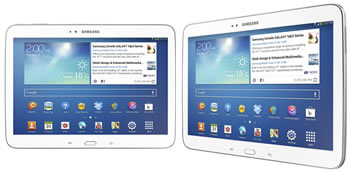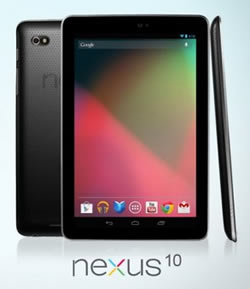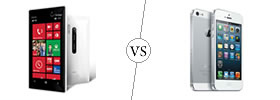Difference between Samsung Galaxy Tab 3 10.1 and Nexus 10
Key Difference: The Samsung Galaxy Tab 3 10.1 is named after the 10.1-inch screen that is offered on the device. The device comes with the same resolution as its 8-inch counterpart, which reduces its ppi density to 149 ppi. The device will be powered by 1.6 GHz dual core Atom processor provided by Intel and will offer 1 GB RAM. The Nexus 10 is a tablet computer running Android 4.2 (also named Jelly Bean) operating system, which was released with it. It was developed in collaboration with Samsung.
 Samsung has taken a very innovative approach to try and cater every customer in the market. The company’s approach includes releasing one model and then releasing variations of that same model. Following the launch of Samsung Galaxy Tab 3 7.0 (7-inch) and Tab 3 8.0 (8-inch), the company has announced the launch of Tab 3 10.1 (10.1-inch). This particular Tab also comes in three different models that further try to please its many customers in the market. One model is basic Wi-Fi and does not offer any GSM support; the second model offers 2G, 3G and Wi-Fi support, while the third model offers 2G, 3G, 4G and Wi-Fi. This approach allows users to spend on what they need.
Samsung has taken a very innovative approach to try and cater every customer in the market. The company’s approach includes releasing one model and then releasing variations of that same model. Following the launch of Samsung Galaxy Tab 3 7.0 (7-inch) and Tab 3 8.0 (8-inch), the company has announced the launch of Tab 3 10.1 (10.1-inch). This particular Tab also comes in three different models that further try to please its many customers in the market. One model is basic Wi-Fi and does not offer any GSM support; the second model offers 2G, 3G and Wi-Fi support, while the third model offers 2G, 3G, 4G and Wi-Fi. This approach allows users to spend on what they need.
The Tab 3 10.1 is named after the 10.1-inch screen that is offered on the device. The device comes with the same resolution as its 8-inch counterpart, which reduces its ppi density to 149 ppi. The tablet comes in the same polycarbonate that is found on the Galaxy phones and has a thick white bezel on the front. The screen has a hardware home button flanked by two capacitive buttons for Back and Menu. In landscape mode, the top of the device has the speaker and the mic. There is nothing else on the front. The sides have a metal band and also various ports including the volume rocker, microSD card slot and the charging port. The back of the device has the Samsung logo above which the rear camera is placed.
The company has added certain extra features in the 10.1 inch but has also slashed a bunch of high-end features. All three models will be available with Android v4.2.2 Jelly Bean that will be customized with Samsung’s TouchWiz UX UI. The device will be powered by 1.6 GHz dual core Atom processor provided by Intel. It will offer 1 GB RAM.
The Tab 3 10.1 will come with two different storage capacities 16 GB and 32 GB, which can be further expanded by 64 GB. The device also offers both rear and front cameras but has reduced the MPs offered in the rear camera to 3MP, while the front has a 1.3 MP camera. The device comes with a non-removable 6800 mAh battery. The company has also added a bunch of apps that makes the device more user friendly such as Samsung Hub, Samsung Kies, Samsung Kies Air, Samsung ChatON, TV-Out (enables users to connect the tab to the TV), etc.
 Among the number of various companies launching phones based on Google’s Android, Google has also launched its own line of smartphones based on Android, called the Google Nexus. Each device in the Nexus line is produced via collaboration between Google and a leading original equipment manufacturer (OEM) partner. The Nexus devices in general have an advantage over other devices in that the Android in the Nexus devices is pure, i.e. the Android does not have any manufacturer or wireless carrier modifications to it, such as a custom graphical user interface. The Android also has an unlockable bootloader to allow further development and end-user modification, all of which is usually blocked on other Android smartphones.
Among the number of various companies launching phones based on Google’s Android, Google has also launched its own line of smartphones based on Android, called the Google Nexus. Each device in the Nexus line is produced via collaboration between Google and a leading original equipment manufacturer (OEM) partner. The Nexus devices in general have an advantage over other devices in that the Android in the Nexus devices is pure, i.e. the Android does not have any manufacturer or wireless carrier modifications to it, such as a custom graphical user interface. The Android also has an unlockable bootloader to allow further development and end-user modification, all of which is usually blocked on other Android smartphones.
The Nexus 10 is a10-inch tablet computer running Android 4.2 (also named Jelly Bean) operating system, which was released with it. It was developed in collaboration with Samsung. It is Google’s second tablet, directly following the Nexus 7. It features a 10.1-inch, 2560×1600 pixel display, which at the time of its release was the highest resolution display for a tablet. The Nexus 10 features a Samsung Exynos 5250 system on chip, a dual-core 1.7 GHz Cortex A15 central processing unit and a quad-core ARM Mali T604 graphics processing unit. The Nexus 10 was launched in two storage sizes, 16 GB and 32 GB
The Nexus 10 features Photo Sphere, a new camera technology that allows one to take 360 deg Panorama shots. The tablet also features a quick settings menu, allows for application of widgets on the lock screen, as well as gesture typing; an updated version of Google Now; and multiple user accounts for tablets. The tablet offers a new share and customize feature that allows multiple users to create their own profile and customize it according to their own needs. The tablet offers a 5 MP rear camera and a 1.9 MP front camera for video chatting. The tablet does not support SIM capability. The device also allows nine people to chat simultaneously using Google Hangouts. The Nexus 10 is available for approximately USD 399, with the price varying depending on the model.
The information for the detailed table about the two devices has been taken from Samsung Mobile Press website, Google website and GSMArena.com.
|
|
Samsung Galaxy Tab 3 10.1 |
Nexus 10 |
|
Launch Date |
Q3/2013 |
November 2012 |
|
Company |
Samsung |
Google; designed in collaboration with and manufactured by Samsung. |
|
Size |
243.1 x 176.1 x 8 mm |
263.9 x 177.6 x 8.9 mm (10.39 x 6.99 x 0.35 in) |
|
Display |
10.1-inch TFT capacitive touchscreen |
Super PLS TFT capacitive touchscreen, 16M colors |
|
Screen |
1280 x 800 pixels (~149 ppi pixel density) 16 M colors |
2560 x 1600 pixels, 10.1 inches (~299 ppi pixel density) |
|
Protection |
- |
Corning Gorilla Glass 2 |
|
Weight |
510 grams |
603g (1.33 lb) |
|
2G Network |
GSM 850 / 900 / 1800 / 1900 |
N/A |
|
3G Network |
HSDPA 850 / 900 / 1900 / 2100 |
N/A |
|
4G Network |
LTE 800 / 850 / 900 / 1800 / 2100 / 2600 |
N/A |
|
GUI |
TouchWiz UX UI |
Pure Android |
|
CPU speed |
1.6 GHz Dual Core processor |
Dual-core 1.7 GHz Cortex-A15 |
|
GPU |
No-official data released |
Quad-core Mali T604 |
|
OS |
Android v4.2.2 (Jelly Bean) |
Android OS, v4.2 (Jelly Bean), upgradable to v4.2.1 (Jelly Bean) |
|
Chipset |
No-official data released |
Exynos 5250 |
|
RAM |
1 GB |
2GB RAM |
|
SIM Size |
microSIM |
N/A |
|
Internal Memory |
16/32GB (11.26/26.16GB available to user) |
16/32 GB storage |
|
Expandable Memory |
Up to 64 GB |
None |
|
Sensors |
Accelerometer, Magnetic, Light |
Accelerometer, gyro, proximity, compass, barometer |
|
Connectivity |
WiFi a/b/g/n (2.4 & 5GHz), WiFi Channel Bonding, WiFi Direct, Bluetooth® 4.0, USB 2.0, Wi-Fi hotspot, USB Host |
WiFi 802.11 b/g/n (MIMO+HT40) Bluetooth NFC (Android Beam) Dual side NFC Micro USB Magnetic Pogo pin charger Micro HDMI 3.5mm headphone jack |
|
Data |
GPRS, EDGE, WLAN, Bluetooth, USB. |
WiFi, NFC, USB |
|
Speed |
HSDPA, 21 Mbps; HSUPA, 5.76 Mbps |
- |
|
WLAN |
Wi-Fi 802.11 a/b/g/n, Wi-Fi Direct, dual-band, Wi-Fi hotspot |
Wi-Fi 802.11 b/g/n, Wi-Fi Direct, DLNA |
|
Bluetooth |
Bluetooth v4.0 with A2DP |
Bluetooth v3.0 with A2DP |
|
USB |
USB v2.0, USB Host |
Micro-USB v2.0 |
|
Primary Camera |
3 MP 2048x1536 pixels |
5 MP, 2592х1936 pixels, autofocus, LED flash |
|
Secondary Camera |
1.3 MP |
1.9 MP |
|
Video |
Playback: 1080p@30fps Recording: 720p@30fps |
1080p@30fps |
|
Camera Features |
Geo-tagging |
Geo-tagging, touch focus, face detection, video-calling |
|
Sound Enhancement |
Sound Alive and Dolby Surround |
No |
|
Audio supported formats |
MP3, AAC/AAC+/eAAC+, WMA, E-AC-3, FLAC, Vorbis, AMR-NB/WB |
MP3/WAV/eAAC+/WMA/ Flac player |
|
Video supported formats |
MPEG4, H.264, H.263, WMV, DivX(1080p Full HD @30fps) |
MP4/H.264/DivX/ WMV player |
|
Battery Capacity |
Non-removable battery, Li-ion 6,800 mAh |
Non-removable lithium-ion polymer 9,000 mAh battery |
|
Talktime |
No official data released |
N/A |
|
Standby Time |
No official data released |
- |
|
Available Colors |
Black, White |
Black |
|
Messaging |
SMS(threaded view), MMS, Email, Push Email, IM |
Email, Push Email, IM, RSS |
|
Browser |
HTML5 |
HTML5 |
|
Radio |
N/A |
No |
|
GPS |
A-GPS + GLONASS |
Yes, with GLONASS |
|
Java |
via Java MIDP emulator |
None |
|
Additional Features |
|
|
Image Courtesy: samsungmobilepress.com, androidheadlines.com









Add new comment